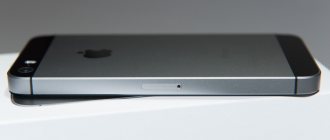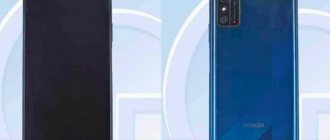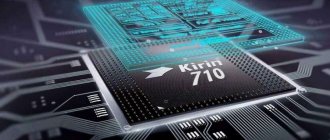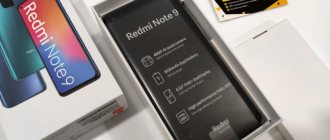Dual 12-megapixel camera, 5.2-inch LCD display with Full HD resolution, fingerprint scanner on the rear panel, 4 GB of RAM, 3000 mAh battery. This is what Huawei P9 and Honor 8 have in common. Differences: Honor has a slightly lower level system-on-chip (Kirin 950 instead of Kirin 955) and it is stated that Leica did not participate in the work on the camera. And this is extremely curious - taking into account the identical characteristics and principle of operation of the module, it is possible to find out whether the influence of famous Germans was so great or whether this is still a classic “name trading”.
Well, yes, the key difference is design. This is where Huawei turned around, creating something reminiscent of the Sony Xperia Z5 Premium - with a mirrored back panel and bright colors.
| Honor 8 and Huawei P9 side by side | ||
In China, Honor 8 was presented last month; the world premiere was traditionally delayed - it will take place on August 24. So you have a chance to read a review of this smartphone not only before sales start, but also before the official presentation. The version of the device is a full-fledged European one, with Russification and local services.
Equipment
Original packaging was made for Honor 8. It looks expensive, neat and doesn’t scream “premium”. The box is shaped like a pencil case, in which the device is located in an unusual way. The gadget is inserted into the slot and when unpacking we see only the side panel. Pulling the “tab” of the internal spacer, we find the standard set for any modern smartphone: instructions, charger, USB Type C cable and a paperclip for accessing the SIM card slot and Micro SD. Headsets, alas, are not provided.
Honor 8 release date, buy, competitors
The Huawei smartphone was released back in July 2016, but the device went on sale only at the end of August at the following prices:
- Honor 8 with 3 GB of RAM and 32 GB of ROM - from 24,000 rubles;
- Honor 8 with 4 GB of RAM and 32 GB of ROM - from 25,500 rubles;
- Honor 8 with 4 GB of RAM and 64 GB of ROM - from 27,500 rubles;
Honor 8 analogs
- Xiaomi Mi5 - from 17,000 rubles;
- Xiaomi Mi5s - from 24,000 rubles;
- LG Nexus 5X (16 GB) - from 18,000 rubles;
- ASUS ZenFone 3 - from 18,000 rubles;
- ZTE Nubia Z11 Mini - from 15,000 rubles;
Design
One of the main advantages of Honor 8 can be called its design. Without knowing the brand, you can easily confuse this phone with more famous competitors.
The body is made of glass and metal. The aluminum alloy frame is covered on both sides with Corning Gorilla Glass 3 with 2.5D technology. All corners are smoothed out and the only protruding parts are the volume rocker and power button on the right side of the device.
Even one of the distinctive features of this smartphone, the dual camera equipped with laser autofocus and dual LED flash, is hidden under the rear glass. All this gives Honor 8 a finished and respectable look, worthy of the best praise. Unless... I’ll add a drop of tar.
The beauty of design, put at the forefront, introduces the danger of the gadget slipping out of your hands and any other surface where you put it. Be careful!
The fingerprint scanner located on the rear side is recessed and positioned in such a way that it is convenient for both right- and left-handed people to use. The index finger always touches it, which is convenient for everyday use. The scanner, in addition to the main unlocking function, is also a button with additional functions that can be customized. There are actually three actions you can use: tap, double-tap, and tap+hold to launch an app or action. A very convenient and original solution!
The front side of the smartphone is not distinguished by the original arrangement of elements. By tradition, they are all located above the display in order from left to right: front camera, proximity and ambient light sensors, earpiece and LED for indicating events, built into the speaker opening.
As for the build quality, it is beyond doubt. The body looks and feels monolithic. There can be no talk of any creaking.
Due to the desire to make the device more universal, all manufacturers began to equip smartphones with a module for two SIM cards. But even here there are some “raisins” - you can use two SIM cards or a SIM card + Micro SD at the same time, which greatly limits the functionality.
Fingerprint's scanner
The fingerprint scanner is located on the back of the device, and it deserves a special mention.
It will no longer be possible to surprise users with 95% accuracy of the fingerprint scanner (tested from personal experience), and the developers took a different route, making the fingerprint scanner at the same time a “smart button”. We have never seen such a solution before, but Honor has implemented it superbly. In a special section, the button can be configured at your discretion.
For example, a regular press opens the camera, a double press turns on the flashlight, and a long press opens any of the selected applications. This is very convenient, since the smartphone does not need to be unlocked and search for the application manually.
You can also use the fingerprint sensor to manage photos and videos, answer calls and turn off the alarm. Moreover, the scanner supports gestures, or rather, swiping your finger across it. In this case, the notification panel opens or photos are scrolled through.
Display
In this parameter, Honor 8 follows the trend in smartphone construction. The phone is equipped with an IPS matrix covered with durable Corning Gorilla Glass 3, measuring 5.2 inches with a comfortable resolution of 1920 x 1080 and a density of 423 pixels per square inch. Since the navigation keys are located on the screen itself, approximately five inches of usable space are available to the user.
The screen has a high enough brightness and contrast so as not to fade in sunlight, and natural color rendering and wide viewing angles do not spoil the picture in almost any position relative to the eyes. True, with large deviations from the normal position, the screen is prone to transmitting cold shades.
The display sensor with Multi-touch technology honestly supports 10 simultaneous touches, and the oleophobic coating resists grease stains for a long time and maintains the original appearance of the device. The gadget also has a glove mode, but you must use it at your own peril and risk, because with gloves it becomes completely elusive and is ready to slip away at the first opportunity.
Sound
It is worth noting that in terms of multimedia audio capabilities, both devices have almost identical characteristics. The main speaker has loud sound, allowing you to comfortably listen to music or watch movies in a small room. The speech speaker broadcasts the interlocutor's voice clearly and intelligibly. The microphone has a noise reduction function, due to which the user’s speech will be perfectly audible to the interlocutor. This function will be especially useful for residents of megacities, since external noise coming from the streets will not spoil the quality of telephone communication.
The devices also have a 3.5 mm mini-jack audio jack for connecting a headset or headphones. In headphones, the sound is more spacious and rich in sound. The devices do not support FM radio, but there is a voice recorder that allows you to record audio recordings. This is convenient, for example, for recording voice memos.
Specifications Honor 8 (FRD-L09)
- HiSilicon Kirin 950 processor (8 cores, 4 x Cortex-A72 (2.3 GHz) + 4 x Cortex-A53 (1.8 GHz), 64-bit)
- Mali-T880 MP4 graphics accelerator with support for OpenGL ES 3.1
- RAM 4 GB LPDDR4 (2880 MB available after reboot)
- built-in storage 32 GB (24.08 GB available for data storage)
- memory expansion via Micro SDHC/SDXC (up to 128 GB supported)
- display with a resolution of 1920 x 1080 (Full HD), 5.2″ diagonal, 423 ppi, IPS
- main cameras 12 MP + 12 MP 3968 x 2976 (f/2.2, dual LED flash, laser autofocus, video recording in Full HD 60 fps)
- front camera 8 MP 3264 x 2448 (f/2.4, video recording in Full HD 60 fps)
- operating system Android 6.0 Marshmallow, EMUI 4.1 (64-bit)
- Sensors: light, proximity, gyroscope, G-Sensor, compass, Hall, fingerprint scanner, NFC, IR port
- ports: USB 2.0 Type C with OTG support, standard 3.5 headset jack
- battery 3000 mAh Li-Ion (non-removable)
- Dimensions: 145.5 x 71.0 x 7.45 mm
- weight 153 g
- available colors: gold, white, black, blue
- average price – 27,990 rubles.
Wireless capabilities:
- GSM (850, 900, 1800, 1900 MHz), HSPA+ up to 42 Mbit/s, LTE Cat. 6 to 300 Mbit/s (FDD bands: 1, 3, 7, 8, 20; TDD bands: 38, 40)
- Supports simultaneous installation of two Nano SIM cards
- Wi-Fi (802.11 a/b/g/n/ac, 2.4 GHz / 5 GHz), Bluetooth 4.2
- navigation using GPS, A-GPS, GLONASS
Battery and autonomy
The autonomy of the smartphone can also be safely attributed to its strengths - the 3000 mAh battery consistently lasts for a day and a half with an average (or even above average) load: calls, instant messengers, social networks, browser, news and other everyday functions with the exception of heavy games. In addition, fast charging support is a great help in this matter. Note that Huawei's proprietary Quick Charge technology is used, and no other technology, for example Qualcomm Fast Charge, works. The original charger only provides fast charging; there is no option for fast/regular charging in the settings.
Here are some small observations:
- 20 minutes in car navigator mode: only 6% of charge consumed.
- 25 minutes of video viewing (Wi-Fi, headphones, medium brightness) - 7%.
- Night (9 hours) in standby mode - 5%.
Performance
In terms of performance, Honor 8 can compete with more famous gadgets. A powerful processor, fast graphics accelerator and four gigabytes of RAM will allow you to comfortably use your smartphone not only for its intended purpose, but also for entertainment.
When launching modern games, you will not feel any discomfort due to the frantic adjustment of the appropriate graphic settings of modern games to the capabilities of the device. At the moment, all toys can be run on Honor 8 with maximum parameters, which will please fans of beautiful graphics and detailed gameplay.
The Honor 8 synthetic benchmark results are shown below.
Also, any user will be pleased to have LTE Cat support on board. 6, with which you can forget about the existence of Wi-Fi. The latter, by the way, has pleasant features in this device. A function called “Wi-Fi+” automatically monitors the signal level of both Wi-Fi and mobile Internet for data transfer and selects the most optimal one for stable Internet access. Thus, by connecting Wi-Fi+, the smartphone will always use the fastest Internet line available.
As for navigation capabilities, the smartphone is equipped with all available means of communication with satellites. The device determines its location almost instantly, so you won’t have to wander around looking for a way out of the maze of the urban jungle.
Returning to the main function of a smartphone, namely telephony, it is worth mentioning the fact that it supports two SIM cards simultaneously.
And all because the device uses two separate radio modules.
This function is implemented very conveniently: during parallel conversations, you can quickly switch from one interlocutor to another by pressing one key.
The connection itself has no complaints, the signal is stable, and the noise reduction works well. Both interlocutors will communicate comfortably without much interference. In addition, there are additional tricks to improve communication with the simple name “Signal+”. The function allows you to receive signals in all directions, thereby improving the quality of voice communications and reducing the percentage of network connection interruptions.
As with all multi-SIM phones, Honor 8 has the ability to distribute calls, data transfers and SMS messages between SIM cards in accordance with personal preferences.
⇡#Camera
Honor 8 camera module
The camera is the most interesting detail in the Honor 8. In the P9 model, Huawei flashed a camera with a unique design with two sensors - RGB and monochrome - and two lenses. And even despite the small size of each sensor individually, this allowed Huawei to become one of the leaders in mobile photography in 2016. Along with this self-developed scheme, the Chinese company also attracted a big name - the luminaries of photography Leica. As Huawei stated, the camera was developed “in close cooperation with German partners.” Now we see exactly the same dual 12-megapixel module in Honor 8, only Leica is no longer mentioned.
Huawei P9 and Honor 8 camera modules
Externally, the difference is visible only in the location of the flash units and autofocus laser illumination - the lenses themselves are no different, although the SUMMARIT inscription is not visible nearby. The characteristics of focal length (equivalent to 27 mm) and aperture (f/2.2) are the same.
The difference is clearly visible in the menu - fonts, film modes have disappeared, as well as the monochrome mode, which was a serious focus in the P9 - and, by the way, quite justified, black and white photographs taken with this device turn out excellent. There is also no possibility of receiving photos in RAW format.
| Honor 8, camera app interface | ||
But the interface logic remained the same. To select a mode, you need to swipe your finger to the right from the left edge; changing the shooting settings occurs in the menu, which “extends” from the right edge. Professional mode, however, can no longer be activated by swiping from the bottom edge; you need to select it from the general list. Honor 8 thus seems to distance itself from its older brother, which is more serious in terms of photo capabilities. Although the proprietary software background blur mode with aperture simulation up to f/0.95 is still in place.
I compared the camera performance of Honor 8 with Huawei P9 directly:
| On the left is a photo taken on Huawei P9, on the right is a photo taken on Honor 8 | ||
| On the left is a photo taken on Huawei P9, on the right is a photo taken on Honor 8 | ||
| On the left is a photo taken on Huawei P9, on the right is a photo taken on Honor 8 | ||
| | ||
| On the left is a photo taken on Huawei P9, on the right is a photo taken on Honor 8 | ||
| On the left is a photo taken on Huawei P9, on the right is a photo taken on Honor 8 | ||
But in terms of the quality of filming, the situations are very similar. As you might expect, Leica mainly influenced the software content, rather than the technical content of the camera. Honor 8, in fact, is inferior only in micro-sharpness obtained during post-processing of images. The main advantages and disadvantages here are the same: excellent dynamic range, moderate detail, quite natural colors, but with a slight bias towards cool tones, a noticeable lack of optical stabilizer when shooting in the dark. This is especially noticeable due to the fact that, in theory, the Honor 8/Huawei P9 camera is better suited for shooting in low light than anyone else on the market - it produces images of detail unprecedented for mobile cameras. General conclusion: if Huawei P9 competed quite confidently and in many respects outperformed its rivals in the flagship segment, then in its class Honor 8 is perhaps the clear leader - Xiaomi Mi5 and Meizu MX6 are not far behind, but still can hardly compare with him.
Honor 8-gallery
View all images (17)The smartphone surprisingly cannot record 4K video - only Full HD. However, the loss is small: the quality of 4K recorded on mobile devices still leaves much to be desired.
The front camera here is identical to the one used on the P9 - 8 megapixels, f/2.4 aperture, no autofocus. You can get a good selfie in normal lighting without any problems, but in the dark there will be problems.
Software
The smartphone comes pre-installed with the latest operating system currently available from Google - a 64-bit version of Android 6.0 Marshmallow with Huawei's own EMUI 4.1 shell.
The EMUI graphical shell developed by Huawei specialists quite significantly changes the native interface of the operating system. At the same time, everything works smoothly, quickly and without any glitches, which is facilitated by productive hardware. Visually everything is very beautiful and intuitive. When you swipe from the top, the notification timeline and phone feature icons drop down.
You can also set the home screen style: “Normal”, which displays application and widget icons on the home screen as standard, and “Simple” with a minimum of applications and large icons.
Modern smartphone users are not only lovers of surfing the World Wide Web, but also lovers of listening to good music on the way to the bright and beautiful. And Honor 8 will be a good travel companion for them. The built-in player, although it does not have sound settings, pleases with high-quality sound - it does not distort the sound track, and if all this is supplemented with good “ears”, then you are guaranteed good musical accompaniment.
Warranty Information
Huawei, like NTS and Motorola before it, offers new customers a grace period: if you accidentally drop the phone and break the screen within 3 months after purchase, the manufacturer will repair it or provide a replacement. This is in addition to the one-year warranty available to all Honor 8 buyers.
The manufacturer's limited warranty covers defects resulting from manufacturing. It does not cover accidental damage such as impacts, scratches or exposure to moisture. Repairs are provided free of charge but do not include delivery and claims expire 12 months from the date of purchase.
Cameras
The main dual camera in a mid-price phone is becoming a trend and good form of any self-respecting manufacturer.
As the manufacturer himself states:
“Honor 8 features a camera with two sensors: RGB and black and white, with a pixel size of 1.25 nm. Two lenses of the main camera with a resolution of 12 megapixels increase the quality and detail of images.”
This Honor 8 module was inherited from Huawei P9, only without the participation of the famous Leica company.
The trick of this camera is that one sensor is responsible for color, and the second (monochrome) for brightness. The information received from both sensors is processed by software and summarized into the final image. All this helps to achieve good color rendition and detail.
There is a laser rangefinder for focusing. There is also a dual flash with “cold” and “warm” LEDs. To complete happiness, the only thing missing is image stabilization.
The originals of all the examples given are available here.
The front camera in the smartphone is an 8-megapixel sensor with a fixed focus and no additional flash. Natural color rendition and good detail will not disappoint selfie lovers. And for those who want to be irresistible, the “Enhance” function has been added, which can smooth out all the troubles in the resulting photos.
Standard selfie
Selfie with Enhance feature
As for the settings, there is something for even a seasoned photographer to play around with. By launching the camera and swiping the screen to the right, we find ourselves in a selection of modes, where in addition to the standard set of preset settings in the form of: night photography, panorama, HDR, etc., we will find the “Pro” mode. Moreover, both for photos and videos. By selecting it, we will be able to control almost any parameter in real time.
“Pro” includes the following settings: focus point selection (center point, center-weighted and the entire screen field), we can set light sensitivity, shutter speed, exposure settings, focus selection (automatic with aperture priority, auto with shutter priority and manual focus ) and, of course, adjusting the white balance.
In addition to shooting modes, there are additional settings brought up by swiping the screen to the left. Here are the frame resolutions, GPS tag, grid, timer and other settings standard for most smartphones.
Both cameras, the front one and the main one, are capable of shooting video with a resolution of 1920 x 1080 pixels at a speed of 30 or 60 frames. The resulting videos have a good picture without noticeable distortions and artifacts. Noise reduction works at the proper level.
Below is an example of a video at 60 frames per second. Full HD resolution.
Health
The developers also decided to take care of the health of users: the smartphone counts steps, distance traveled and calories burned, and a special application processes the information and allows you to monitor your physical activity.
The application is almost completely identical to that installed for Xiaomi fitness trackers, only the latter also include sleep tracking. In the program you also need to set your age, height and weight, as well as goals: how many steps you plan to take per day and what weight you are aiming for.
We tested the smartphone simultaneously with the Mi Band 2, so we had something to compare with. Surprisingly, Honor 8 counts steps perfectly - the final difference in the indicator at the end of the day was insignificant, although it ranged from 100 to 300 steps in favor of the Mi Band. But here it is worth considering that the bracelet was not removed from the hand at all, and the smartphone sometimes lay on the table.
Battery life
The capacity of the battery installed in Honor 8 is 3000 mAh, which gives good autonomy. With everyday use of the device in the following modes: conversation for 30-40 minutes, Internet via Wi-Fi / LTE ~ 4-6 hours and a little photo / video art - it will be enough for a full working day.
With games, the situation is not changing for the better. Since the gadget allows you to play all modern titles with maximum settings, charging will last for 3-4 hours of active gameplay.
With all this, the developers claim that using proprietary energy-saving technology Smart Power 4.0, “the smartphone provides up to 1.77 days of operation with normal use and up to 1.22 with intensive use” and this seems to be true.
"Killer" of flagships
Huawei faced stiff competition from the ZTE Axon 7, Alcatel Idol 4S, OnePlus 3 and Lenovo Moto Z. It seemed keen to prove that it could successfully compete in the flagship killer segment.
The Honor brand is a giant of the Chinese industry. Under this name, 40 million smartphones were sold in 2015 alone. The Chinese company was looking to replicate its success in the United States. And she bet on Huawei Honor 8. The characteristics of the model made it unique in the world of smartphones - the exterior finish is different from anything that has ever been produced. And its hardware fully matches its appearance.
However, the technical characteristics of Huawei Honor 8 are one thing, but everyday use is another. Can the phone cope with long working days and increased workload on weekends?
Bottom line
Yes, Honor 8 is a little behind the flagships of 2016 in terms of hardware power (at least in numbers), but we can confidently say that it is one of the best smartphones of 2016, a balanced, stylish and fast device that is pleasant to hold in the hand.
Pros:
- high speed;
- excellent cameras;
- glass design and ergonomics;
- display with excellent color rendering and brightness;
- concise and convenient proprietary interface;
- good autonomy.
Minuses:
- rapid appearance of scratches on the glass;
- slippery body.











